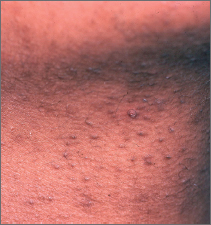What is pseudofolliculitis barbae (PFB)?
In some men with curly hair, the area under the chin, upper neck, or cheeks can be subject to an uncomfortable cluster of bumps known as “papules,” which can make shaving very difficult.
These bumps can really become itchy and painful, and they may scar and heal with dark spots.
The term “folliculitis” simply refers to any inflammation or infection of hair follicles. PFB is more commonly called “razor bumps.”
Pseudofolliculitis barbae (razor bumps)
A curly hair grows from a sharply curved hair root. When shaved, the hair is left with a sharp point. As this hair grows, it makes a “U-turn,” and the sharp tip curves back and pierces the skin.
On the other hand, when hairs are cut too closely, they sometimes grow underneath the skin.
Most African-American people have curved hair follicles, and their cut hair may be sharply pointed.
If aimed toward the body, this cut hair can grow right back into the skin.
Pseudofolliculitis barbae (razor bumps)
Don't pluck hairs because new hairs will again grow from below and penetrate a site that is already inflamed.
Allow your hairs to grow long enough so they will not grow back into the skin.
The key is to reduce the closeness of the shave so that you lessen the chance of ingrown hairs. Hairs cut too short are at risk of curling into the skin while growing and causing more razor bumps.
Avoid a close shave by using a guarded razor. Two recommended products are the PFB Bump Fighter or the Aveeno PFB Bump Fighter Razor. Both of these products should be available at your local drug store.
Soften your hairs before shaving. Try shaving after you take a warm shower. Steaming helps soften your beard. Washing your face before shaving removes oil and causes hairs to become more erect, making them easier to cut. Lather the beard area with a nonirritating, lubricating shaving gel such as Aveeno Therapeutic Shave Gel, Edge, or a benzoyl peroxide-containing prescription shaving foam such as Benzashave.
Use shaving gels to hydrate your hairs and to provide lubrication between the razor blades and your skin.
Shave with downward strokes; “go with the grain.” Shaving in the same direction that the hair lies (typically down) results in less pull on the hairs and less tendency to cut them too short.
Minimize repeat shaving strokes. Repeated shaving may result in hairs being cut too short.
Don't stretch the skin during shaving, because this leads to a closer shave and increases the chances of producing ingrown hairs.
Many methods are available for temporary or permanent hair removal, including the following:
Chemical depilatories: depilatories remove hair from the surface of the skin. For PFB, chemical depilatories such as Magic Shave and Royal Crown Powders are effective in removing and softening hairs. These products dissolve the hairs but can be too strong and cause chemical burns on facial skin.
Removing hairs permanently: techniques of permanent epilation include electrolysis, thermolysis, and laser epilation.
Outline


